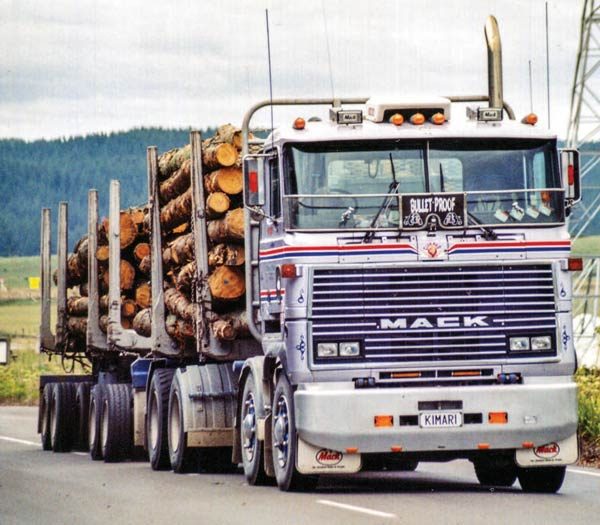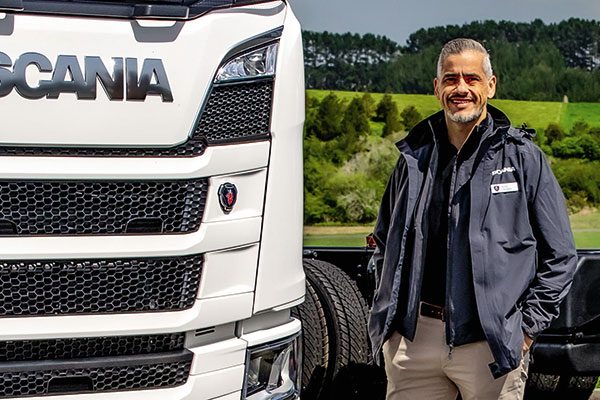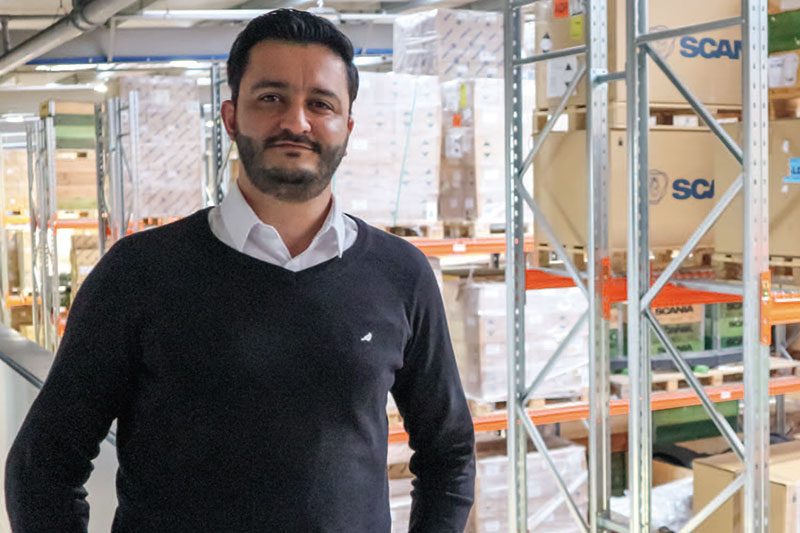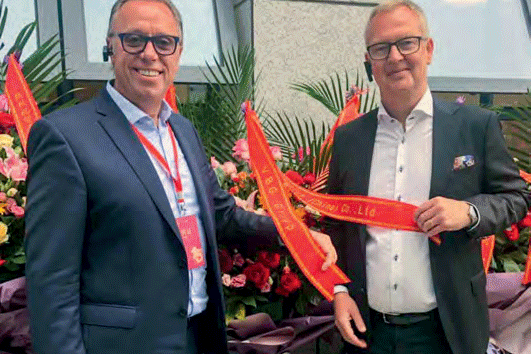PERSON OF INTEREST Holiday special – A man for his time
At the IRTENZ conference in October 2017, Warwick Wilshier was presented with the IRTENZ Outstanding Industry Achievement Award for services to log truck safety.

Photo: Warwick
Warwick was a founding member of the Log Truck Safety Council (LTSC) in
“They had a big workshop in the Waipa Sawmill and they also had their own log trucks, so that‘s where I probably got my interest for log trucks. When I finished my time I managed to buy one of the contractor‘s businesses so started as an
Warwick‘s grandfather had a timber mill and he says he was brought up around forests – in those days native forests. “I was always keen on something to do with trucks or forestry. I lived in Rotorua and we started hauling from Kaingaroa Forest – that was my first contract – to the Waipa Sawmill. I think there were 10 or 12 owner-drivers and some company trucks. I did that for a few years and then we obviously picked up an additional contract with the NZ Forest Service hauling to Kinleith, and grew our business from there.” In the late

Photo: The truck that got him started in 1982. Still in the fleet today as a yard truck.
“By that time we‘d started a company called Paragon Haulage, which operated initially here in the Bay of Plenty then expanded into Northland. For a short
“We have two depots, one here in Rotorua and one in Gisborne, and the operation is split about 50:50. We have about 100 staff and every year the drivers haul about 1.2m logs and cover about 6,000,000
Warwick says the industry was under a pretty heavy threat that all trailers would be taken off the road if the crashes continued. “Back then they were quoting stats of one in 11 log trucks would roll over every year. There weren‘t a lot of log trucks on the road

Photo: A new Kenworth in young company ‘getting into it‘ on Te Ngae Rd
Warwick says improved vehicle stability was one factor, also changing the culture of the drivers and looking at the loads being transported. “We engaged with the wider industry and did a roadshow. We explained to the drivers what the issues were, a bit about vehicle dynamics, and we explained to all the parties why we put these voluntary measures in place, and then things just developed from there.” The Logging Industry Research Organisation (LIRO) was also involved and facilitated the group being set up. “You had to get everyone to buy into it. There were all sorts of measures that we put into place from there, while we were trying to redesign logging vehicles. We started monitoring some of the crashes and built a rollover database. We looked at where the high crash areas were, the corners that really needed attention, we put in place the 10-Below campaign that‘s still out there today, and at one stage we even monitored those corners to make sure those vehicles were
“At the
“We‘re now at 23

Photo: Owner-drivers have played a significant part in the Williams and
“They used a bit of research from overseas and developed what they called the SRT calculator. It was a paper-based calculation that an operator could do, measuring the wheelbase of the trailer, the height of the bolster bed, the height of the payload, and come up with this calculation of SRT. From there the government picked it up. By then there was
“Mark McCarthy was one of the founding members. One of the ones who really drove it who is not with us today was Martin Hyde; he put an enormous amount of effort in, particularly around canvassing people in government agencies and politicians. He did an enormous amount of work to get longer, lower, safer vehicles. He really believed in it, that was his passion.”
Warwick says so many people were involved that he would be hard-pressed to mention them all, but they all played a part in the success of the LTSC. “There were a lot of guys who are still in business today, but there has been a core group that has driven it; that‘s always the way in industry


Photos: The face of
“When they first developed the National Certificate in Road Transport, we developed a separate strand for a National Certificate for log truck drivers. A lot of the guys in the council didn‘t believe that really acknowledged the experience of a driver, so we developed what we call the log transport LTSC Pathway Programme.” Warwick says Glen Heybourne, who was at the time general manager of Stuart Drummond in Nelson, but now works for Heavy Trucks as a salesman, was very passionate about driver training, as was Mark McCarthy. “We‘ve gone on to develop these different qualifications and this pathway that acknowledges industry experience. But all the time it was about lifting the professionalism in the industry. It‘s a known fact the money you spend
“Back then you had to have certain qualifications to obtain some of your contracts, so right from then we had systems and processes that were part of our contract requirements, and along with that came good health and safety management, and training. That‘s probably put the logging industry, the log transport sector, well ahead. It‘s a high-risk industry so we can‘t afford to have risk-takers or unskilled people.” The improved safety brought about from the establishment of the LTSC has put a big onus on companies to employ drivers who will maintain the gains achieved. “The main players in our team like Mark and myself are passionate and it‘s pretty gutting when there are accidents, particularly if they involve fatalities. Both of us run reasonably big fleets, by no means the size of other companies in New Zealand, but you honestly don‘t expect accidents to happen. You feel confident with the equipment you run, and the skill of the drivers that you employ, that it shouldn‘t happen.” He says logging is not an easy game; they cart a low-value commodity in what is potentially a high-risk industry.
“Therefore you are expected to perform at 100% of your game at all times.

This all comes on top of the latest vehicle enhancements such as ABS and EBS and roll stability control. Warwick says because a log truck is either loaded or carrying the trailers on the back, until recently they had an exemption from the
With the continually improving technology, the concern is how to cope with the huge growth in the industry. “We might be investing in new equipment, but somebody‘s buying our old equipment, so there‘s still an element of risk out there on the road. But maybe it doesn‘t do the number of ks we do in a year and it‘s not used all the time. There‘s still a good market for it.” THE LTSC doesn‘t just concern itself with vehicle safety and driver training, it also looks at the health of the drivers. “Martin brought it to the table and said, ‘a lot of our drivers are getting older, we really need to understand what their health issues are‘. They all want to stay in the industry as long as they can, they don‘t want to be forced to retire. What came out of the initial health study was obviously trucks drivers have an elevated risk of heart disease because of the type of job it is – they might carry a bit of extra weight, their diets were not that good – so our older drivers were facing a few of those issues.”
Another issue was the type of work log truck drivers had to do, particularly throwing chains
Warwick said the results were interesting, that apart from health issues there was an issue of fatigue, and that fatigue problems were higher in younger drivers who had to balance their work and home life with young children. “We typically start early in the mornings and finish midafternoon so they had to balance all that sort of lifestyle. We found that as drivers got older, they didn‘t have the same fatigue risk, because by then their children had left home.” This data was looked at alongside the data on truck rollovers, and they discovered the highest risk of rollover was on a Monday or Tuesday, and then the risk flattened out, which was totally the opposite of what they expected.
Warwick says the reason behind that was the early morning starts and early afternoon finishes. The drivers were doing that Monday to Friday, and by the end of the

Photo: Majestic machines and mighty loads.
“We don‘t use the old standard twitches and bars
“It‘s definitely broken the barriers as far as getting people to understand what we do. That‘s a big one. Log trucks are the face of forestry; the only thing that people in the public understand about trees is log trucks, so there‘s a huge responsibility on us. It‘s probably about the third biggest export earner, and all people see is log trucks, so it‘s a big challenge.”
Read more
People and purpose
0 Comments14 Minutes
A new normal
0 Comments9 Minutes
Faithful following
0 Comments10 Minutes
Fitting right in!
0 Comments16 Minutes





